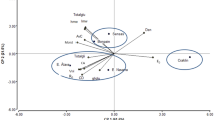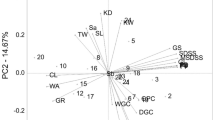Abstract
Over recent decades, several types of ancient grain varieties have been reintroduced through organic farming systems. In the past 20 years, there has been a renewed interest in growing spelt, and this species has a market niche in Europe and North America in natural, organic and healthy products. Are there any differences between commercial wheat varieties and spelt? The analysis of the bread-making quality of three bread wheat and two spelt cultivars has found no significant differences between the two types of wheat in protein, Fe or Zn, although differences were observed between cultivars. In mean quality parameters, a marked difference was observed between the bread wheat and spelt cultivars, the latter having poorer alveo-consistographic characteristics, indicative of weaker gluten and dough. With the exception of the variety ‘Craklin’, the gliadin/glutenin (Gli/Glu) ratio is negatively correlated with the technological quality of cultivars. Principal component analysis shows that the two commercial wheats ‘Bonpain’ and ‘Sensas’ lying close to gluten strength parameters; and, dough extensibility was associated with total gliadin content and the Gli/Glu ratio, both types of spelt being more closely related to these parameters, indicating that spelts are associated with greater dough extensibility.

Similar content being viewed by others
References
McFadden ES, Sears ER (1946) The origin of Triticum spelta and its free-threshing hexaploid relatives. J Hered 37:81–89. https://doi.org/10.1093/oxfordjournals.jhered.a105590
Bonafaccia G, Galli V, Francisci R, Mair V, Skrabanja V, Kreft I (2000) Characteristics of spelt wheat products and nutritional value of spelt wheat-based bread. Food Chem 68:437–441
Gómez-Becerra HF, Erdem H, Yazici A, Tutus Y, Torun B, Ozturk L, Cakmak I (2010) Grain concentrations of protein and mineral nutrients in a large collection of spelt wheat grown under different environments. J Cereal Sci 52:342–349. https://doi.org/10.1016/j.jcs.2010.05.003
Escarnot E, Dornez E, Verspreet J, Agneessens R, Courtin CM (2015) Quantification and visualization of dietary fibre components in spelt and wheat kernels. J Cereal Sci 62:124–133. https://doi.org/10.1016/j.jcs.2015.01.003
Gupta RB, Shepherd KW (1990) Two-step one-dimensional SDS–PAGE analysis of LMW subunits of glutelin. Theor Appl Genet 80:65–74
Wieser H, Seilmeier W, Belitz HD (1994) Quantitative determination of gliadin subgroups from different wheat cultivars. J Cereal Sci 19:149–155
Morris CF (2002) Puroindolines: the molecular genetic basis of wheat grain hardness. Plant Mol Biol 48:633–647
Giroux MJ, Morris CF (1997) A glycine to serine change in puroindoline b is associated with wheat grain hardness and low levels of starch-surface friabilin. Theor Appl Genet 95:857–864
Chen F, He Z, Xia X, Xia L, Zhang X, Lillemo M, Morris C (2006) Molecular and biochemical characterization of puroindoline a and b alleles in Chinese landraces and historical cultivars. Theor Appl Genet 112:400–409. https://doi.org/10.1007/s00122-005-0095-z
Singh NK, Shepherd KW, Cornish GB (1991) A simplified SDS-PAGE procedure for separating LMW subunits of glutenin. J Cereal Sci 14:203–208
Payne PI, Law CN, Mudd EE (1980) Control of homoeologous group I chromosomes of the high-molecular-weight subunit, a major protein of wheat endosperm. Theor Appl Genet 58:113–120
McIntosh RA, Yamakazi Y, Dubcovsky J, Rogers WJ, Morris C, Appels R, Xia XC (2013) Catalogue of gene symbols for wheat 2013. In: 12th international wheat genetics symposium 8–13 September 2013, Yokohama, Japan
Giraldo P, Rodríguez-Quijano M, Simón C, Vázquez JF, Carrillo JM (2010) Allelic variation in HMW glutenins in Spanish wheat landraces and their relationship with bread quality. Span J Agric Res 8:1012–1023
Espí A, Giraldo P, Rodríguez-Quijano M, Carrillo JM (2012) A PCR-based method for discriminating between high molecular weight glutenin subunits Bx7 and Bx7* in Triticum aestivum L. Plant Breed 131:571–573. https://doi.org/10.1111/j.1439-0523.2012.01961.x
Ribeiro M, Rodríguez-Quijano M, Giraldo P, Pinto L, Vázquez JF, Carrillo JM, Igrejas G (2017) Effect of allelic variation at glutenin and puroindoline loci on bread-making quality: favorable combinations occur in less toxic varieties of wheat for celiac patients. Eur Food Res Technol 243:743–752. https://doi.org/10.1007/s00217-016-2788-8
Saghai-Maroof MA, Soliman KM, Jorgensen RA, Allard RW (1984) Ribosomal DNA spacer-length polymorphisms in barley: mendelian inheritance, chromosomal location, and population dynamics. Proc Natl Acad Sci 81:8014–8018
Ribeiro M, Nunes FM, Guedes S, Domingues P, Silva AM, Carrillo JM, Rodríguez-Quijano M, Branlard G, Igrejas G (2015) Efficient chemo-enzymatic gluten detoxification: reducing toxic epitopes for celiac patients improving functional properties. Sci Rep 5:18041. https://doi.org/10.1038/srep18041
AACC (2010) Approved methods of the American association of cereal chemists, 11th edn. AACC International, St. Paul, MN, USA
Vázquez JF, Chacón EA, Carrillo JM, Benavente E (2018) Grain mineral density of bread and durum wheat landraces from geochemically diverse native soils. Crop Pasture Sci 69:335–346. https://doi.org/10.1071/CP17306
Dick JW, Quick JS (1983) A modified screening test for rapid estimation of gluten strength in early-generation durum wheat breeding lines. Cereal Chem 60:315–318
SAS Institute Inc (1996) The SAS system for windows. 6.12 edition. SAS Institute Inc. (ed.). Cary
Di Rienzo JA, Casanoves F, Balzarini MG, González L, Tablada M, Robledo CW (2011) InfoStat version 2013. Grupo InfoStat, FCA, UN de Córdoba, Argentina
Branlard G, Dardevet M (1985) Diversity of grain protein and bread quality. II. Correlation between high molecular weight subunits of glutenin and flour quality characteristics. J Cereal Sci: 345–354
Gobaa S, Kleijer G, Stamp P (2007) 2, a new high molecular weight glutenin subunit coded by Glu-A1: its predicted structure and its impact on bread-making quality. Plant Breed 126:1–4. https://doi.org/10.1111/j.1439-0523.2006.01313.x
Cornish BF, Eagles HA, Payne P, Wrigley C, Bushuk W (2006) In: Wrigley C, Békés F, Bushuk W (eds) Gliadin and glutenin. The unique balance of wheat quality. AACC International, St. Paul, Minessota 55121, USA
Rodríguez-Quijano M, Vázquez JF, Carrillo JM (1990) Variation of high molecular weight glutenin subunits in Spanish landraces of Triticum aestivum ssp. vulgare and ssp. spelta. J Genet Breed 44:121–126
Rasheed A, Xia X, Yan Y, Appels R, Mahmood T, He Z (2014) Wheat seed storage proteins: advances in molecular genetics, diversity and breeding applications. J Cereal Sci 60:11–24. https://doi.org/10.1016/j.jcs.2014.01.020
Ng PKW, Pogna NE, Mellini F, Bushuk W (1989) Glu-1 allele compositions of the wheat cultivars registered in Canada. J Genet Breed 43:53–59
Yan Y, Hsam SLK, Yu JZ, Jiang Y, Ohtsuka I, Zeller FJ (2003) HMW and LMW glutenin alleles among putative tetraploid and hexaploid European spelt wheat (Triticum spelta L.) progenitors. Theor Appl Genet 107:1321–1330. https://doi.org/10.1007/s00122-003-1315-z
An X, Li Q, Yan Y, Xiao Y, .Hsam DLK, Zeller FJ (2005) Genetic diversity of European spelt wheat (Triticum aestivum ssp. spelta L.em. Thell.) revealed by glutenin subunit variations at the Glu-1 and Glu-3 loci. Euphytica. https://doi.org/10.1007/s10681-005-9002-6
Pogna NE, Mellini F, Beretta AM, Dal Belin Peruffo A (1989) The HMW-GS of common wheat cultivars grown in Italy. J Genet Breed 43:17–24
Bagulho AS, Muacho MC, Carrillo JM, Brites C (2003) Influence of glutenin and puroindoline composition on the quality of bread wheat varieties grown in Portugal. In: Lafiandra D, Masci S, D’Ovidio R (eds) The gluten Proteins, Proceedings of the 8th international gluten workshop, Universita `degli Studi della Tuscia', Viterbo, Italy. The Royal Society of Chemistry, Cambridge, UK, pp 113–116
Branlard G, Dardevet M (1985) Diversity of grain proteins and bread wheat quality: i. Correlation between gliadin bands and flour quality characteristics. J Cereal Sci 3:329–343
Van Lonkhuijsen HJ, Hamer RJ, Schreuder C (1992) Influence of specific gliadins on the breadmaking quality of wheat. Cereal Chem 69:174–177
Khatkar BS, Fido RJ, Tatham AS, Schofield JD (2002) Functional properties of wheat gliadins. II. Effects on dynamic rheological properties of wheat gluten. J Cereal Sci 3:307–313. https://doi.org/10.1006/jcrs.2001.0429
Kohajdová Z, Karovičová J (2008) Nutritional value and baking applications of spelt wheat. Acta Sci Pol Technol Aliment 7:5–14
Pruska Kedzior A, Kedzior Z, Klockiewicz Kaminska E (2008) Comparison of viscoelastic properties of gluten from spelt and common wheat. Eur Food Res Technol 227:199–207. https://doi.org/10.1007/s00217-007-0710-0
Labuschagne MT, Claassen A, Van Deventer CS (1997) Biscuit-making quality of backcross derivates of wheat differing in kernel hardness. Euphytica 96:263–266
Branlard G, Dardevet M, Saccomano R, Lagoutte F, Gourdon J (2001) Genetic diversity of wheat storage proteins and bread wheat quality. Euphytica 119:59–67
Filipčev B, Šimurina O, Bodroža-Solarov M, Obreht D (2013) Comparison of the bread-making performance of spelt varieties grown under organic conditions in the environment of northern Serbia and their responses to dough strengthening improvers. Hem In 67:44453. https://doi.org/10.2298/HEMIND120606083F
McRitchie F (1987) Evaluation of contributions from wheat protein fractions to dough mixing and bread making. J Cereal Sci 6:259–268
Barak S, Mudgil D, Khatkar BS (2013) Relationship of gliadin and glutenin proteins with dough rheology, flour pasting and bread making performance of wheat varieties. LWT-Food Sci Technol 51:211–217. https://doi.org/10.1016/j.lwt.2012.09.011
Acknowledgements
The authors would like to thank the Diputación Foral de Álava for their collaboration with this work. This work was supported by Grant No. AGL 2016-77149 from the Spanish Ministry of Economy and Competitiveness.
Author information
Authors and Affiliations
Corresponding author
Ethics declarations
Conflict of interest
The authors declare that they have no conflict of interest.
Compliance with ethics requirements
This article does not contain any studies with human or animal subjects.
Additional information
Publisher’s Note
Springer Nature remains neutral with regard to jurisdictional claims in published maps and institutional affiliations.
Rights and permissions
About this article
Cite this article
Rodríguez-Quijano, M., Vargas-Kostiuk, ME., Ribeiro, M. et al. Triticum aestivum ssp. vulgare and ssp. spelta cultivars. 1. Functional evaluation. Eur Food Res Technol 245, 1561–1570 (2019). https://doi.org/10.1007/s00217-019-03263-7
Received:
Revised:
Accepted:
Published:
Issue Date:
DOI: https://doi.org/10.1007/s00217-019-03263-7




